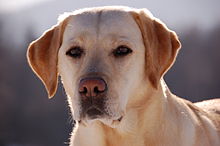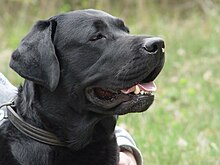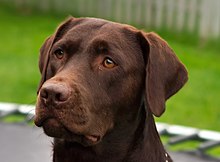#1: Labrador Retriever
The Labrador Retriever, also known as simply Labrador or Lab, is one of several kinds of retrievers, a type of gun dog. Labradors are athletic, playful, and the most popular breed of dog by registered ownership in Australia, Canada, New Zealand, the United Kingdom, and the United States (since 1991).
A favourite assistance dog breed in these and other countries, Labradors are frequently trained to aid people who are blind and people with autism, act as therapy dogs, and perform screening and detection work for law enforcement and other official agencies. They are prized as sporting and waterfowl hunting dogs. A few kennels breeding dogs were in England; at the same time a combination of sheep protection policy (Newfoundland) and rabies quarantine(England) led to their gradual demise in Canada, their country of origin.
The first and second Earls of Malmesbury, who bred for duck shooting on his estate, and the 5th and 6th Dukes of Buccleuch, and youngest son Lord George William Montagu-Douglas-Scott, were instrumental in developing and establishing the modern Labrador breed in 19th century England. The dogs Avon ("Buccleuch Avon") and Ned given by Malmesbury to assist the Duke of Buccleuch's breeding program in the 1880s are considered the ancestors of modern Labradors.
The first St. John's dog was said to be brought to England in or around 1820; however, the breed's reputation had spread to England long before. There is a story that the Earl of Malmesbury saw a St. John's dog on a fishing boat and immediately made arrangements with traders to have some of these dogs exported to England. These ancestors of the first labradors so impressed the Earl with their skill and ability for retrieving anything within the water and on shore that he devoted his entire kennel to developing and stabilizing the breed.
Early descriptions

Buccleuch Avon (b. 1885), a foundational dog of many modern Labrador lineages.
Several early descriptions of the St. John's water dog exist. In 1822, explorer W.E. Cormack crossed the island of Newfoundland by foot. In his journal he wrote
"The dogs are admirably trained as retrievers in fowling, and are otherwise useful.....The smooth or short haired dog is preferred because in frosty weather the long haired kind become encumbered with ice on coming out of the water."
Another early report by a Colonel Hawker described the dog as
"by far the best for any kind of shooting. He is generally black and no bigger than a Pointer, very fine in legs, with short, smooth hair and does not carry his tail so much curled as the other; is extremely quick, running, swimming and fighting....and their sense of smell is hardly to be credited...."
In his book Excursions In and About Newfoundland During the Years 1839 and 1840, the geologist Joseph Beete Jukes describes the St. John's water dog.
"A thin, short-haired, black dog came off-shore to us to-day. The animal was of a breed very different from what we understand by the term Newfoundland dog in England. He had a thin, tapering snout, a long thin tail, and rather thin, but powerful legs, with a lank body, – the hair short and smooth." wrote Jukes. "These are the most abundant dogs in the country...They are no means handsome, but are generally more intelligent and useful than the others...I observed he once or twice put his foot in the water and paddled it about. This foot was white, and Harvey said he did it to "toil" or entice the fish. The whole proceeding struck me as remarkable, more especially as they said he had never been taught anything of the kind."
Name
The foundational breed of what is now the Labrador Retriever was known as the St. John's water dog, St. John's dog, or Lesser Newfoundland. When the dogs were later brought to England, they were named after the geographic area known as "the Labrador" (they were known as Labrador Retrievers because they "retrieved" in the Labrador Sea) or simply Labrador to distinguish them from the larger Newfoundland breed, even though the breed was from the more southern Avalon Peninsula. The Labrador retriever is actually from Newfoundland; exceptionally, the Newfoundland (dog) was created near the same time in Labrador. The two breeds' names and origins were mixed once moved into England and the Americas. The dog from Labrador became the large, long furred dog we see and know today, and the dog from Newfoundland became the Labrador.
Historical landmarks
The first written reference to the breed was in 1814 ("Instructions to Young Sportsmen" by Colonel Peter Hawker), the first painting in 1823 ("Cora. A Labrador Bitch" by Edwin Landseer), and the first photograph in 1856 (the Earl of Home's dog "Nell", described both as a Labrador and a St. Johns dog).< By 1870 the name Labrador Retriever became common in England. The first yellow Labrador on record was born in 1899 (Ben of Hyde, kennels of Major C.J. Radclyffe), and the breed was recognised by The Kennel Club in 1903. The first American Kennel Club (AKC) registration was in 1917. The chocolate Labrador emerged in the 1930s, although liver spotted pups were documented being born at the Buccleuch kennels in 1892. The first dog to appear on the cover of Life Magazine was a black Labrador Retriever called ‘Blind of Arden’ in the December, 12th, 1938 issue. The St. John's dog survived until the early 1980s, the last two individuals being photographed in old age around 1981.
History of subtypes

Ben of Hyde (b. 1899), the first recognized yellow Labrador.
Yellow and chocolate pups would occasionally appear (although often culled), until finally gaining acceptance in the 20th century. The first recognized yellow Labrador was Ben of Hyde, born in 1899, and chocolate Labradors became more established in the 1930s., There is also a significant difference between show Labs, which tend to be short legged and very heavy, and field Labs which have a more functional and athletic build. Generally these two subtypes have different general features such as facial or body types.
Yellow (and similar shades)
In the early years of the breed through to the mid-20th century, Labradors of a shade we would now call "yellow" were in fact a dark, almost butterscotch, colour (visible in early yellow Labrador photographs). The shade was known as "Golden" until required to be changed by the UK Kennel Club, on the grounds that "Gold" was not actually a colour. Over the 20th century a preference for far lighter shades of yellow through to cream prevailed, until today most yellow Labradors are of this shade. Also fawn has been a common colour in the yellow lab variety.
Interest in the darker shades of gold and fox red were re-established by English breeders in the 1980s, and three dogs were instrumental in this change: Balrion King Frost (black, born c. 1976) who consistently sired "very dark yellow" offspring and is credited as having "the biggest influence in the re-development of the fox red shade", and his great-grandson, the likewise famous Wynfaul Tabasco (b. 1986), described as "the father of the modern fox red Labrador", and the only modern fox red Show Champion in the UK. Other dogs, such as Red Alert and Scrimshaw Placido Flamingo, are also credited with passing on the genes into more than one renowned bloodline.
Chocolate Labradors
Jack Vanderwyk traces the origins of all chocolate Labradors listed on the LabradorNet database (some 34,000 Labrador dogs of all shades) to eight original bloodlines. However, the shade was not seen as a distinct colour until the 20th century; before then according to Vanderwyk, such dogs can be traced but were not registered. A degree of crossbreeding with Flatcoat or Chesapeake Bay retrievers was also documented in the early 20th century, prior to recognition. Chocolate Labradors were also well established in the early 20th century at the kennels of the Earl of Feversham, and Lady Ward of Chiltonfoliat.
The bloodlines as traced by Vanderwyk each lead back to three black Labradors in the 1880s—Buccleuch Avon (m), and his sire and dam, Malmesbury Tramp (m), and Malmesbury June (f). Morningtown Tobla is also named as an important intermediary, and according to the studbook of Buccleuch Kennels, the chocolates in this kennel came through FTW Peter of Faskally (1908).
Description
Appearance

The head of a Labrador should be broad with a pronounced stop.

Black Labrador Retriever

Chocolate Labrador
Labradors are relatively large, with males typically weighing 65 to 80 lb (29 to 36 kg) and females 55 to 70 lb (25 to 32 kg). Labradors weighing close to or over 100 lb (45 kg) are considered obese or having a major fault under American Kennel Club standards, although some Labradors weigh significantly more. The majority of the characteristics of this breed, with the exception of colour, are the result of breeding to produce a working retriever.
As with some other breeds, the Conformation (typically "English", "show" or "bench") and the Field (typically "American" or "working") lines differ, although both lines are bred in both countries. In general, however, Conformation Labradors tend to be bred as medium-sized dogs, shorter and stockier with fuller faces and a slightly calmer nature than their Field counterparts, which are often bred as taller, lighter-framed dogs, with slightly less broad faces and a slightly longer nose. However, Field Labradors should still be proportional and fit within American Kennel Club standards. With Field Labradors, excessively long noses, thin heads, long legs, and lanky frames are not considered standard. These two types are informal and not codified or standardised; no distinction is made by the AKC or other kennel clubs, but the two types come from different breeding lines. Australian stock also exists; though not seen in the West, they are common in Asia. These dogs are also very good with children.
The breed tends to shed hair twice annually or regularly throughout the year in temperate climates. Some Labradors shed considerably; however, individual Labradors vary. Labrador hair is usually short and straight, and the tail is quite broad and strong. The webbed toes of the Labrador Retriever make them excellent swimmers. The webbing between their toes can also serve as a "snowshoe" in colder climates and keep snow from balling up between their toes—a condition that can be painful to other breeds with hair between the toes. Their interwoven coat is also relatively waterproof, providing more assistance for swimming.
Official breed standards
There is a great deal of variety among Labradors. The following characteristics are typical of the conformation show bred (bench-bred) lines of this breed in the United States and are based on the American Kennel Club standard. Significant differences between UK and US standards are noted.
- Size: Labradors are a large breed. They should be as long from the withers to the base of the tail as they are from the floor to the withers. Males should stand 22.5 to 24.5 inches (57 to 62 cm) tall at the withers and weight 65 to 80 lb (29 to 36 kg). Females should stand 21.5 to 23.5 inches (55 to 60 cm) and weigh 55 to 70 lb (25 to 32 kg). By comparison under UK Kennel Club standards, height should be 22 to 22.5 inches (56 to 57 cm) for males, and 21.5 to 22 inches (55 to 56 cm) for females.
- Coat: The Labrador Retriever's coat should be short and dense, but not wiry. The coat is water-resistant, so the dog does not get cold when taking to water in the winter. That means that the dog naturally has a slightly dry, oily coat. Acceptable colours are black, yellow, and chocolate.
- Head: The head should be broad with slightly pronounced eyebrows. The eyes should be kind and expressive. Appropriate eye colours are brown and hazel. The lining around the eyes should be black. The ears should hang close to the head and set slightly above the eyes.
- Jaws: The jaws should be strong and powerful. The muzzle should be of medium length and should not be too tapered. The jaws should hang slightly and curve gracefully back.
- Body: The body should have a powerful and muscular build.
The tail and coat are designated "distinctive [or distinguishing] features" of the Labrador by both the Kennel Club and AKC.